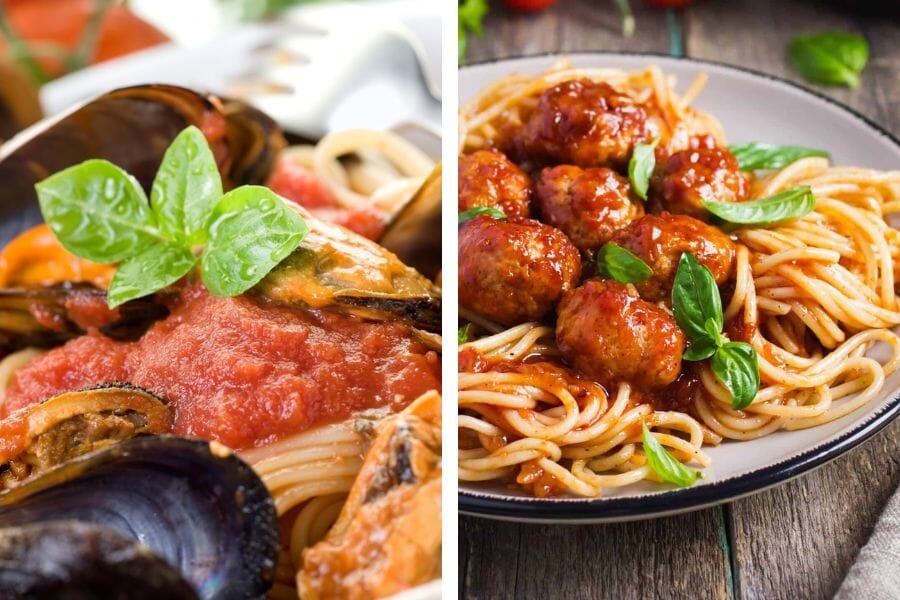How is Italian Pasta Different from American Pasta?

Pasta is a unique culinary creation that has become the backbone of most households across cultures and kitchens globally. Although Italian and American pasta may seem alike at first glance, the two bear significant differences in preparation, making, and consumption. To investigate these differences, the expert at Burrata House will delve into how Italian pasta differs from American variations.
Difference Between Italian & American Pasta Explained by Burrata House
Below are the differences explained by culinary experts.
The Traditional Way of Creating Italian Pasta
Italian pasta is always associated with tradition, and its preparation technique follows tradition. In traditional Italian cooking, high-grade semolina flour was used along with water to form a perfect dough. The dough is rolled into thin sheets and cut into various shapes, from straightforward spaghetti to elaborate ones such as farfalle and orecchiette.
American pasta, on the other hand, is usually more industrialized. Many American pasta brands are made with durum wheat semolina; however, the mass production methods often need to be revised to account for the delicate texture and taste of Italian pasta.
All Natural Ingredients Used
One of the primary differences is in what they use as ingredients. Pasta at the best Italian restaurant in Los Angeles gets its unique texture and nutty taste from semolina flour, coarsely ground with durum wheat. The dough is usually prepared with water and semolina without using eggs.
On the other hand, American pasta recipes are mostly accompanied by eggs, giving their version of it a richer flavor and a different texture. While both approaches have their benefits, the question of ingredients can be seen as a critical contributor to many differences between Italian and American pasta.
It is essential to have the Right Quantity of Water
The perfect texture in Pesto Pasta from Burrata House depends on correcting the water-to-flour ratio. Italian pasta making focuses on the ideal elastic but not sticky balance. Pasta dough is usually rested briefly so the gluten can relax and produce a more tender pastry when rolled out.
Sometimes, American pasta may be prepared with a greater hydration level because eggs are added. This can produce a smoother mouthfeel, attracting people who enjoy heartier pasta.
A Proper Balance of Ingredients
The fact that Italian pasta can be simple even in its ingredients extends to the amounts used. Italian pasta is famous for its balanced ratio of ingredients like Burrata cheese, making a delicious and uniform dish.
American pasta recipes are delicious, but sometimes extra ingredients and spices are added to make it tastier and suit the taste buds. American pasta dishes can vary from a wide range of textures and flavors.
Italian Pasta is Always Fresh
Another significant distinction is the freshness of the pasta. Italian people love making pasta from scratch, and sometimes, on the same day, they consume it. This focus on freshness provides a refreshing flavor that we at Burrata House ensure.
Dried pasta materials are well-represented in the United States, and many Americans appreciate them because of their convenience for cooking. However, Italy’s regular diet is cooked freshly made pasta. This distinction distinguishes the cultural value attached to the savoring authenticity in ingredients.
Italian Pasta is Part of the Course
In Italy, pasta is a part of the seven to ten-course Italian meal. It is usually served as a primo (first course), followed by another second with meat or fish, and finished with dessert. This approach enables a more balanced and diverse food experience that you can have at the best Italian restaurant in Los Angeles.
In the United States, pasta is often served as a side dish or snack, following numerous toppings and sauces. This disparity in serving practice can indicate each region's broader culture associated with dining traditions.
No Meatballs with Spaghetti
Unlike popular belief, a plate of spaghetti and meatballs is not an authentic Italian food. In Italy, a common practice is to serve pasta with Burrata cheese and meat separately so that the latter appears as part of the second dish. Pairing meatballs with spaghetti is an Italian-American invention, which signifies that a pasta dish can fit into various gastronomic settings.
There are only minor differences in the Italian and American styles of pasta. Still, these subtle aspects remain significant to the very diverse sphere of this particular type. The traditional methods, ingredient choices, and cultural nuances make Italian and American pasta different. People choose the simplicity and freshness of Italian pasta or the heartiness and diversity of American pasta. Contact our experts at Burrata House to learn more about the differences.
Frequently Asked Questions
Why is Italian pasta prepared without eggs?
With semolina flour and water being the only ingredients used, it is possible to emphasize their authentic flavor and pasta texture at Burrata House.
Why is pasta served as an antipasti course in Italy?
In the Italian way of eating out, pasta is perceived as a primo or first course followed by another second course, which will either comprise meat products or fish and finally round up with a delicious dessert.
Is spaghetti with meatballs genuinely Italian?
The combination of spaghetti with meatballs is not Italian. This is an Italian-American invention which shows the flexibility and adaptability of pasta in different culinary scenes. In Italy, pasta and meat are not served together.

